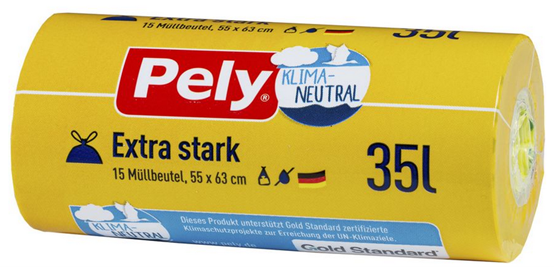Advertising with environmental reference – CLIMATE-NEUTRAL
The case: In a test case, the Wettbewerbszentrale sought clarification of whether the use of the term CLIMATE-NEUTRAL as an environmental reference on rubbish bags made by Pely-plastic GmbH & Co KG was misleading:

The clearly visible blue box on the packaging contained the following information:

![]()
In the first instance, the Regional Court of Kiel confirmed that the statement was misleading.
In its view, the combination of ‘Pely®’ and ‘CLIMATE-NEUTRAL’ itself points to the climate neutrality of all the company’s products sold under the ‘Pely’ brand. However, the company as a whole was not climate neutral. The Higher Regional Court of Schleswig, however, disagreed, saying that consumers understand that product branding, as in this case, ‘Pely’, is often used on the packaging of different products. The consumer would not therefore assume that the combination of ‘Pely®’ and ‘CLIMATE-NEUTRAL’ referred to products other than the specific bin liners.
The Regional Court of Kiel had also objected to the fact that the packaging did not explain in detail how climate neutrality was achieved. The mere reference to the support of Gold Standard projects was not sufficient. The consumer must be able to decide whether or not to support the projects in question by buying the product. While a web address had been given, in terms of being eye-catching, it contained only general information and gave the incorrect impression that the entire company was climate-neutral.
It is true that a strict standard applies to advertising that contains environmental protection terms and ecolabels. According to the case law of the Federal Court of Justice, when somewhat fuzzy environmental terms are used, such as ‘environmentally friendly’, ‘environmentally compatible’, or ‘organic’, there must also be a specific explanation as to what the environmental advantage is. Such fuzzy terms are associated with contradictory expectations, ideas and emotions. If no information is provided, the consumer could be misled about the properties attributed to the product.
However, the Higher Regional Court rightly stated that the term CLIMATE-NEUTRAL does not fall into this category. According to a general understanding, the term only promises that the production attempts to balance CO2 emissions. This can be achieved through compensatory measures such as the purchase of CO2 certificates. Similarly, the standard relating to environmental labels and declarations, DIN EN ISO 14021, p. 47, item 7.17.3.1, assumes that the term ‘CO2 neutral’ refers to a carbon footprint equal to zero or offset.
In addition, it was clearly indicated on the packaging that climate neutrality is achieved by offsetting, namely by supporting Gold Standard projects. More information, too extensive to be accommodated on the packaging, was made available by the provision of the web address. This was necessary, but also sufficient for packaging design. Package inserts would be too strict a requirement for bin liners.
Whether the information on the website itself was misleading had no relevance to the admissibility of the packaging design. Only the packaging design had been challenged. It therefore did not matter whether on its website the company in reality was only feigning its climate neutrality across the board, which is what the district court had assumed.
The court also rejected the applicant’s suggestion that it should be required to affix notices such as:
- ‘100% climate neutral thanks to our own efforts’ or
- ‘20% climate neutral thanks to our own efforts and 80% through purchased certificates for climate protection projects in developing countries.’
Such references would themselves have the potential to mislead because the stated numerical ratios could not be reliably determined.
The Higher Regional Court of Schleswig (OLG), judgment of 30 June 2022, 6 U 46/21
As a supplement to this decision, the Federal Patent Court in a recent ruling rejected the registration of the claim ‘NaturNeutral’ (NatureNeutral) as a German word mark. The claim is devoid of distinctive character because it refers only to the environmental standards of the goods or services claimed. This also reflects the position with regard to the terms ‘climate neutral’, ‘environmentally neutral’ or ‘CO2 neutral’.
BPatG, judgment of 14 September 2021, 25W(pat)585/20
Learnings: If you want to highlight the environmental properties of your products, first check whether the signs or terms used for this purpose, such as CLIMATE-NEUTRAL or ‘environmentally friendly’, are clear and unambiguous. If they are not, you must explain what the sign or term in question actually means. If the production of only one of your products meets the environmental characteristics in question, but not your entire company, all claims/environmental details must refer only to the specific product, otherwise you run the risk of being held liable for misleading consumers, encouraging them to commit to a purchase using such an environmental claim.
Words such as ‘climate neutral’, ‘environmentally neutral’ or ‘CO2 neutral’ cannot be protected as a German trademark. For their registration, you need a distinctive design.